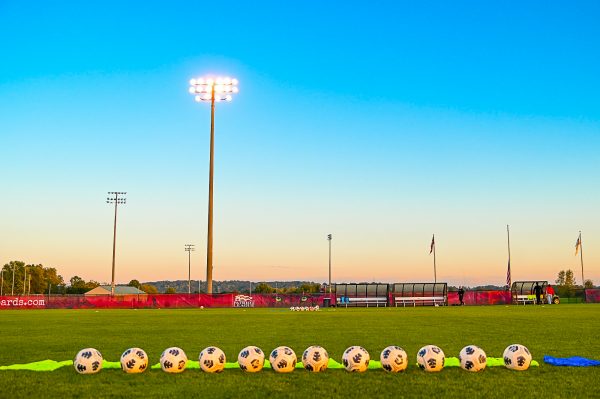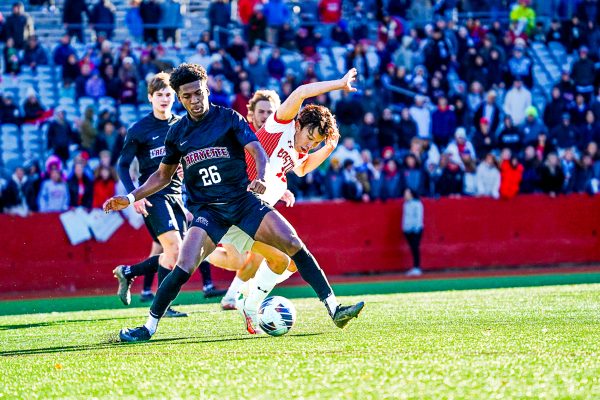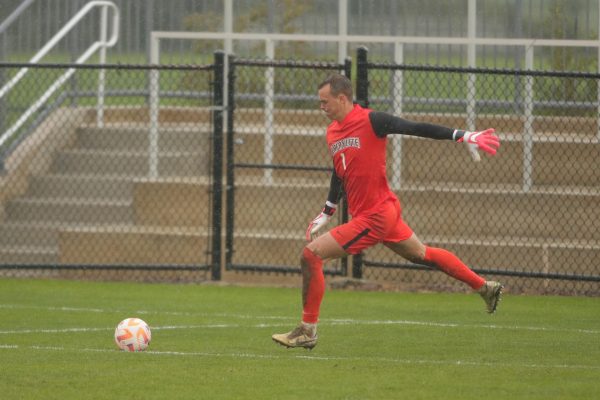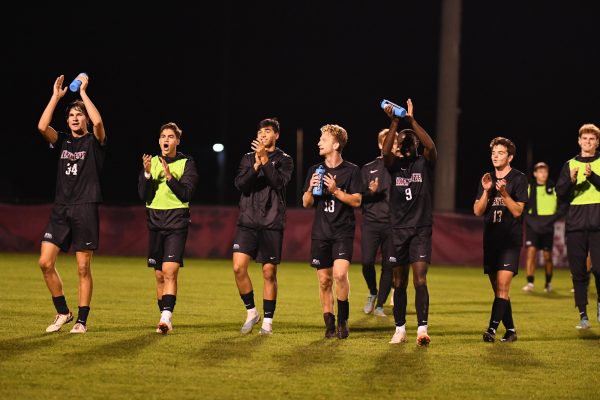How is the sport industry related to the climate crisis?
David Goldblatt, author of ‘The Ball is Round’ discussed the connection between the world sports industry and climate change during a visit to Professor Ospina-Giraldo’s FYS class. (Photo courtesy of FIFA World Football museum)
October 29, 2021
Not only are sports threatened by the climate crisis, but they contribute to the climate problem. Writer and journalist David Goldblatt spoke on these issues in addition to the carbon footprint generated by the sports industry, what to do about these dilemmas and how to prompt a change.
Goldblatt, author of The Ball is Round: A Global History of Soccer, spoke to the Lafayette community over Zoom last Tuesday. The visit was geared towards the First Year Seminar, ‘Fútbol: Inside the Beautiful Game’ with Professor of biology Manuel Ospina-Giraldo, but was open to the entire campus.
“[The course] explores the ways in which football (soccer) arguably has become a major force uniting, or dividing, ethnic and racial groups, driving economies, contributing to climate change, supporting dictatorships, effecting social change, and last but not least, providing entertainment,” Ospina-Giraldo wrote in an email.
The class discusses topics including racism, homophobia, sectarianism, xenophobia, sexism and misogyny. Another important discussion topic in the class is how authoritarian regimes have used the sport to seek out legitimization or support for their government.
Goldblatt was born in London in 1965 and studied medicine and sociology at Cambridge University. He wrote his Ph.D. thesis on social theory and the environment, and on globalization and global history.
In 2006, he published The Ball is Round and has also published other works about soccer. Additionally, he has written for The Guardian, The Observer, The Financial Times, The New York Times, The Washington Post, New Statesman and New Left Review.
The Ball is Round is one of the essential readings for Ospina-Giraldo’s students. The class discusses topics from the book including “the origins of football and the colonialism of the English, the women’s game, and hooliganism and the European crisis of the 80’s and 90’s,” Ospina-Giraldo said.
Goldblatt has also won the Foreign Media Association’s “Sports Story of the Year” three times, and in 2020 he helped found Football for Future, campaigning for a carbon-zero global game.
Many sports are played outdoors, which means the weather and climate determine how sports are played and how we watch them. Goldblatt explained how both winter and summer sports are threatened–or even potentially extinguished–by the climate crisis.
He explained that under current climate models and research from the University of Waterloo, by 2050 half of Winter Olympic hosts may have to cancel due to a lack of snow. These events will instead require artificial snow.
“The gloomy predictions [by Waterloo] are most likely an underestimate,” Goldblatt said.
Summer sports will soon be experiencing lethal levels of heat, which greatly affect grassroots sports. For example, football during the day in Equatorial Africa outside in 2050 will be impossible due to high temperatures.
In 2026, the Men’s World Cup is scheduled to be hosted in Seattle, U.S. However, climate projections based on recent years have not been promising. Seattle experienced extreme humidity this year during the same time the tournament is scheduled to be held. Therefore, we will likely lose a major sporting competition because of unbearable heat and humidity.
With hurricanes and typhoons becoming increasingly intense and more frequent, coastal sports all over the world are being affected. For example, rowing and sailing events were moved in the Tokyo Olympics due to strong typhoons.
Next, Goldblatt discussed sports’ contribution to the climate problem and the carbon footprint generated by the sports industry.
“The global sports industry is worth five hundred to seven hundred billion dollars a year, not including the clothing or gambling industries that are parasitic upon it,” Goldblatt said.
He explained that nonrenewable energy use, food production and consumption, and transport are the main ways sports impact the environment.
Carbon footprint data from the Olympics and World Cups show that 60-70% of emissions come from spectator transportation.
Ospina-Giraldo pointed out how carbon footprint offset can be problematic, as it doesn’t completely address the root of the issue. A student in the class asked Goldblatt what individuals can do to help, and the answer was that “there is structural change, institutional change, and individual change.” Overall, not all of the blame can be placed on the individual.
“Students should push institutions to divest from fossil fuels and to pursue sustainability projects,” Ospina-Giraldo wrote. “Students should strive to make decisions that are in line with a sustainable future.”
Lastly, Goldblatt discussed what the world of sports has been doing about these dilemmas in order to change the way they consume water, food, and energy. He explained that people didn’t really make the connection between sports and climate until the 1960s.
In 1974, Republicans and Democrats came together and opposed the 1976 Denver Winter Olympics because public tax money would have been required and the Games would have been destructive to local ecosystems.
In 1994, Norwegians hosted the first “Green Olympics,” but the consequences of the global climate crisis did not fully come into play for the sports industry until the late 2000s.
European countries are at the forefront of working toward carbon neutrality in sports by 2050. An example of this is in Germany, where game tickets qualify the ticket holder for free public transport and personal parking is closed off for match day. Goldblatt explained that this is an idea currently spreading across Europe.
“The role of sports, but particularly football, in climate change is undeniable. There is a lot that can be done to address the problem, but it needs to be done now,” Ospina-Giraldo wrote. “Hope is not lost, as football clubs in Europe, the place of origin of most of the carbon emissions associated with football, have started to tackle the issue with green stadiums and zero- or negative-emissions activities.”
Goldblatt emphasized that athletes have the reach and power to bring these issues to the public eye on social media, and they have the opportunity to normalize climate politics.
“Sports are a space where people don’t believe it’s over until it’s over,” Goldblatt said. “It’s a place of hope, and if they can mobilize that type of cultural language, it can be a catalyst for the wider climate change.”

















































































































